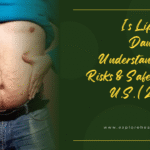Introduction: Does Azelaic Acid Cause Purging?
Azelaic acid is having a moment in the U.S. skincare scene. From prescription creams to over-the-counter serums, it’s quickly becoming a go-to solution for acne, rosacea, and uneven skin tone. But one question keeps popping up: Does azelaic acid cause purging?
If you’ve recently started using it and noticed a breakout, don’t panic. You might be experiencing what dermatologists call “purging.” But what exactly does that mean—and is it a good or bad sign?
In this article, we’ll break down the science behind azelaic acid, explain what purging really is, and help you figure out whether your breakout is temporary or a red flag. Whether you’re new to actives or just curious about how your skin is reacting, this guide is for you.
What Is Azelaic Acid?
Azelaic acid is a naturally occurring compound found in grains like barley and wheat. In skincare, it’s used in concentrations ranging from 10% (OTC) to 15–20% (prescription). It’s known for its anti-inflammatory, antibacterial, and exfoliating properties.
What It Treats
- Mild to moderate acne
- Rosacea (especially redness and bumps)
- Hyperpigmentation and melasma
- Post-acne marks and discoloration
It’s considered safe for all skin types, including sensitive and acne-prone skin, and is often recommended when other treatments like benzoyl peroxide or retinoids are too harsh.
For more, the National Library of Medicine offers in-depth clinical data supporting its effectiveness.
What Is Skin Purging?
Skin purging happens when a new product accelerates cell turnover, bringing clogged pores to the surface faster than usual. This may cause:
- Small whiteheads or blackheads
- Pustules or papules
- Temporary increase in acne
It’s not a reaction to the product itself—more like a “fast-forward” of breakouts that were already brewing under the surface.
Does Azelaic Acid Cause Purging?
The Short Answer: It Can, But It’s Not Always Common
Azelaic acid is a mild exfoliant, meaning it doesn’t increase skin turnover as aggressively as ingredients like retinoids or glycolic acid. However, for some users—especially those with congested pores—it can cause a brief purging period.
According to dermatologists, purging from azelaic acid typically:
- Starts within the first 1–3 weeks
- Peaks around week 2–4
- Resolves within 4–6 weeks
If your skin starts breaking out after this window, or the breakouts are unusual (itchy, inflamed, painful), it might be a reaction or irritation, not purging.
Signs You’re Experiencing Purging (Not a Reaction)
| Symptom | Purging | Irritation/Allergic Reaction |
| Timeline | Starts within 1–3 weeks | Can happen immediately or gradually |
| Duration | Resolves in 4–6 weeks | Worsens over time without improvement |
| Breakout Type | Small pimples in usual areas | Redness, swelling, burning, itchiness |
| Skin History | Areas you usually break out | New or unusual areas |
| Sensation | Mild discomfort or dryness | Severe burning or stinging |
If you’re experiencing extreme redness, flaking, or painful bumps, stop use and consult a dermatologist.
Why Azelaic Acid Is Less Likely to Cause Purging
Unlike more aggressive actives like retinoids or beta hydroxy acids (BHAs), azelaic acid:
- Has a gentle exfoliating action
- Works gradually over time
- Targets bacteria and inflammation directly
This makes it a preferred option for people with sensitive skin or rosacea, and it’s frequently recommended by dermatologists as a starter treatment.
You can read more about its skin compatibility in resources from the American Academy of Dermatology.
Tips for Managing Purging from Azelaic Acid
If you suspect your skin is purging, don’t give up just yet. Here are smart ways to manage it:
1. Start Slowly
Use azelaic acid every other night for the first 1–2 weeks. Gradually increase to nightly use as tolerated.
2. Simplify Your Routine
Avoid mixing azelaic acid with other harsh actives like:
- Retinol
- Vitamin C (L-ascorbic acid)
- AHA/BHA exfoliants
Stick to a basic routine:
- Gentle cleanser
- Azelaic acid
- Moisturizer
- Sunscreen (AM only)
3. Moisturize Generously
A good moisturizer helps support your skin barrier, minimizing irritation and speeding up recovery.
Look for products with:
- Ceramides
- Hyaluronic acid
- Niacinamide
4. Be Consistent
Don’t skip too many days or overuse. Steady use leads to better, more predictable results.
What Dermatologists Are Saying in 2025
With rising demand for well-tolerated acne treatments, dermatologists across the U.S. are prescribing azelaic acid more often—especially for patients with:
- Rosacea
- Darker skin tones prone to hyperpigmentation
- Hormonal acne
In fact, according to a 2024 U.S. survey published in Dermatology Times, 20% of acne patients aged 18–35 were prescribed azelaic acid as a first-line treatment.
That number is expected to grow in 2025, thanks to increasing consumer awareness and product availability in both prescription and OTC formulations.
Over-the-Counter vs. Prescription Azelaic Acid
| Type | OTC (10%) | Prescription (15–20%) |
| Available In | The Ordinary, Paula’s Choice | Finacea, Azelex |
| Strength | Lower concentration | Higher concentration |
| Uses | Mild acne, brightening | Moderate acne, rosacea |
| Insurance Coverage | Not covered | Often covered for medical conditions |
If your skin is sensitive or you’re new to azelaic acid, start with an OTC option and monitor your skin’s response. For persistent concerns like rosacea, speak with a board-certified dermatologist.
When to See a Dermatologist
See a professional if:
- Your breakout worsens after 6 weeks
- You develop painful cysts or nodules
- You suspect an allergic reaction
- Your skin becomes dry, itchy, or inflamed despite moisturizer use
You can find a local dermatologist through the American Academy of Dermatology directory.
U.S. Trends to Watch in 2025
Growing Popularity in Diverse Skin Types
Azelaic acid is praised for its minimal risk of post-inflammatory hyperpigmentation (PIH), making it ideal for melanin-rich skin. Brands are now formulating products specifically targeting uneven tone in Black and Latino communities.
FDA-Backed Research Expands
As of 2025, multiple clinical trials funded by the National Institutes of Health (NIH) are underway to explore the benefits of azelaic acid for:
- Perioral dermatitis
- Post-inflammatory erythema
- Acne scars
More data is expected to support broader insurance coverage and new OTC releases.
Conclusion: Does Azelaic Acid Cause Purging?
To wrap it up: Yes, azelaic acid can cause purging, but it’s usually mild, short-lived, and manageable. Because it’s gentler than other actives, most people experience few to no issues. And if you’re seeing some breakouts early on—it might just be your skin adjusting to a better future.
Be patient, simplify your routine, and monitor your skin. And if in doubt, a dermatologist can guide you based on your skin’s unique needs.
If you’ve been asking “does azelaic acid cause purging,” now you have your answer. It might—but that’s not always a bad thing. Ready to give it a try or adjust your skincare strategy? Take it slow, stay consistent, and check in with your skin regularly.
For more science-backed skincare guides and health tips, head to ExploreHealthToday.com—your trusted destination for informed wellness decisions in 2025 and beyond.
About ExploreHealthToday.com
ExploreHealthToday.com was created to be a one-stop resource where readers can find up-to-date, well-researched articles on a variety of health topics. From nutrition and wellness to lifestyle and mental health, we strive to provide reliable information to help you make informed decisions about your well-being.
We believe that good health starts with good information, and our mission is to empower our readers with knowledge they can trust.
Visit us at ExploreHealthToday.com to learn more.





